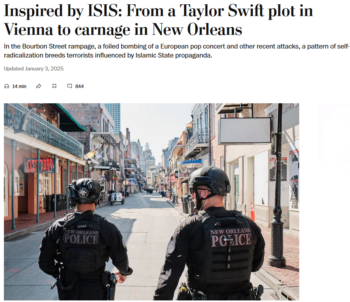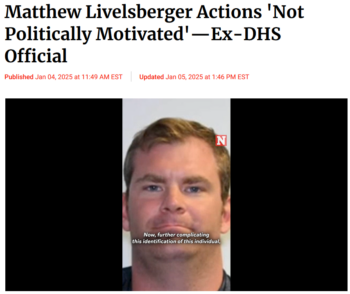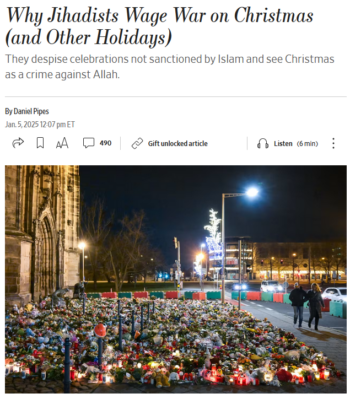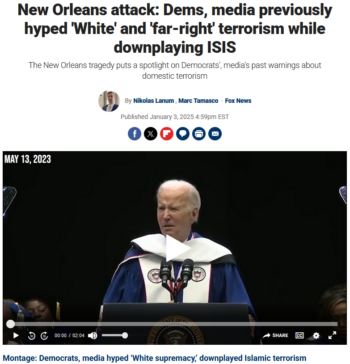Three vehicular attacks in public areas shocked the world this past holiday season. First was the attack on a Christmas market in Magdeburg, Germany, which killed six people and injured dozens (Reuters, 1/6/25). Then there was the New Year’s attack in New Orleans’ French Quarter, killing at least 14 people and injuring more (CNN, 1/2/25). A suicide car explosion outside the Trump International Hotel in Las Vegas on New Year’s Day only killed the attacker, but injured bystanders (NBC, 1/1/25).
In the German case, the Saudi-born suspect, Taleb al-Abdulmohsen, had a history of dark social media posts, including a declaration of far-right, anti-Islamic positions. In New Orleans, the killer, Shamsud-Din Jabbar, who did not survive the attack, declared his support for the Islamic State of Iraq and Syria (ISIS). In Las Vegas, the suspected suicide bomber, former Green Beret Matthew Livelsberger, left behind chaotic anti-government, pro-Trump rants.
Corporate media framed these attacks differently, focusing on Jabbar’s Islamist beliefs but downplaying Abdulmohsen and Livelsberger’s political stances. The right-wing press, predictably, did this to an extreme.
‘The US homeland isn’t safe’

Washington Post (1/3/24): “Islamic State…is still a potent source of radicalization.”
In the New Orleans case, the New York Times (e.g., 1/2/25, 1/4/25) focused on Jabbar’s Islamic radicalization and support for ISIS, using these facts in the leads and sometimes headlines. “New Orleans Attacker Was ‘Inspired’ by ISIS, Biden Says,” read the headline of an early Times report (1/1/25).
The Washington Post did the same, in articles like “Attacker With ISIS Flag Drives Truck Into New Orleans Crowd, Killing 15” (1/2/24) and “Inspired by ISIS: From a Taylor Swift Plot in Vienna to Carnage in New Orleans” (1/3/24).
Jabbar is believed to have acted alone (Wall Street Journal, 1/2/25), although he was clearly inspired by the notorious entity. Because both he and the Las Vegas attacker had served many years in the US military, the incidents raised questions about mental health for active service members and veterans (The Hill, 1/4/25). Jabbar’s brother speculated that mental health issues could have been at play (ABC, 1/2/25).
Yet the acronym ISIS still loomed large in the news stories and headlines, and it is clearly one that can spark fear in the hearts of news consumers.
‘Puzzled over the motive’

Reporting on the Germany attack, CBS (12/30/24) highlighted the possibility of mental illness, not the suspect’s far-right views.
Just as the “Islamic radicalism” framing can whip up anti-Islamic sentiment in the United States, where a notorious Islamophobe is set to become president, the Magdeburg suspect’s Saudi origin has explosive potential in Germany’s polarized political moment. The far-right Alternative for Deutschland (AfD) has used the situation to advance its anti-immigrant agenda (Al Jazeera, 12/23/24; Le Monde, 12/24/24). But there’s a twist: Abdulmohsen held and voiced similar political views to the AfD’s.
The New York Times (12/22/24) and the Washington Post (12/21/24), to their credit, did put this fact up top in their coverage. But elsewhere, the coverage was more muddled, focusing more on the possibility of mental illness rather than Abdulmohsen’s professed extremism.
CBS (12/30/24) coverage of the attack placed suspected mental illness in its headline and lead; it wasn’t until the ninth paragraph that we learned that the suspect “has in the past voiced strongly anti-Islam views and sympathies with the far right in his social media posts,” and showed “anger at Germany for allowing in too many Muslim war refugees and other asylum-seekers.”
NPR’s All Things Considered (12/23/24) began by talking about how the far-right AfD is using the attack to whip up anti-immigrant sentiment ahead of the country’s snap election. It wasn’t until about halfway through that the story acknowledged that police “say, if anything, the suspect claimed, especially on social media, to be an anti-Islamist.”
In other words, coverage of the New Orleans attack centered Jabbar’s professed devotion to ISIS, while coverage of the German attack downplayed Abdulmohsen’s politics, treating them as part of a constellation of factors, including possible mental illness, that could have contributed to the bloodshed.
‘No ill will toward Trump’

A Newsweek headline (1/4/25) declared the Las Vegas attack “not politically motivated”—despite the suspect’s expressed hope that his actions would inspire “military and vets [to] move on DC starting now…to get the Dems out of the fed government.”
The same journalistic approach used in the Magdeburg case was taken when a Tesla Cybertruck exploded outside a Trump hotel in Las Vegas. While that juxtaposition might make it easy to assume that this was some kind of anti-Republican terrorism, that would be incorrect, according to Talking Points Memo (1/4/25): Documents left by Livelsberger, the truck’s driver who died in the blast,
denounce Democrats and demand they be “culled” from Washington, by violence if necessary, and express the hope that his own death will serve as a kind of bell clap for a national rebirth of masculinity under the leadership of Donald Trump, Elon Musk and Bobby Kennedy Jr.
TPM lamented that news headlines “report only that [Livelsberger] warned of national decline and bore ‘no ill will toward Mr. Trump,’ in the words of one of the investigators,” rendering his political motives vague and outside of the central framing.
For example, an AP article (1/3/25) said only that Livelsberger’s “letters covered a range of topics including political grievances, societal problems and both domestic and international issues, including the war in Ukraine,” and that he believed the US was “‘terminally ill and headed toward collapse.’”
ABC‘s report (1/4/25) addressed Livelsberger’s support for the president-elect seven paragraphs in. CNN (1/4/25) gave one line in passing to Livelsberger’s support for Trump, Musk and Kennedy. Using a quote from one former Department of Homeland Security official, Newsweek (1/4/25) declared that the attack in Las Vegas was “not politically motivated.” A piece in The Hill (1/2/25) on “extremism in the military” started by citing Jabbar and Livelsberger as examples, but while it described Jabbar’s Islamacist views, it said only that “less is known about the motivation of Livelsberger.”
Fox News (1/2/25) did acknowledge that Livelsberger’s uncle said of him, “He loved Trump, and he was always a very, very patriotic soldier, a patriotic American,” but it is buried after many other details. Interestingly, it was the New York Post (1/2/25) who directly framed Livelsberger as a super-macho Trump lover, while a long Wall Street Journal piece (1/2/25) on Livelsberger published the same day detailed the man’s personal life with hardly a mention of his political beliefs.
‘War on Christmas’

The Wall Street Journal (1/5/25) tied the German attack into the “war on Christmas” the Murdoch empire has been pushing for two decades.
The US right-wing press was far worse. After the New Orleans attack, Fox News (1/2/25) featured guests who warned that more Islamic terrorism could be on the way, because the attack “could embolden the terrorist organization to radicalize more Americans.”
“It occurred just days after a pro-ISIS outlet called on Muslims to wage Islamic jihad in the US, Europe and Russia,” the right-wing network (1/1/25) reported.
“One obvious message is that the forces of Islamic radicalism haven’t gone away,” the Wall Street Journal editorial board (1/1/25) wrote. “They are still looking for security weaknesses to exploit for mass murder, and the US homeland isn’t safe from foreign-influenced or -planned attacks.”
Meanwhile, Abdulmohsen’s right-wing, anti-Islamic politics didn’t stop the Wall Street Journal (1/5/25) from giving column space to neoconservative pundit Daniel Pipes, who cited the incident in a piece titled “Why Jihadists Wage War on Christmas (and Other Holidays),” with the subhead, “They despise celebrations not sanctioned by Islam, and see Christmas as a crime against Allah.”
The New York Post (1/2/25) did something similar, allowing Douglas Murray—a younger, British version of Pipes—to cite the German attack in a piece called “From College Campuses to Afghanistan, We Let Islamic Terrorism Rise Again.”
It simply didn’t matter to these Murdoch outlets that Abdulmohsen shared Pipes’ and Murray’s politics. He is Saudi and he committed a crime in Europe, therefore he must be the second coming of Osama bin Laden.
Right-wing terror on the rise

Fox News (1/3/25) used the New Orleans attack to chide Democrats for talking about right-wing terrorism—ignoring the Las Vegas attack the next day that aimed to get Americans to “rally around the Trump, Musk, Kennedy.”
Meanwhile, Fox News (1/3/25) used the New Orleans attack to say that the Biden administration had focused too much on right-wing extremism over ISIS threats:
Democrats and liberal media outlets were focused on hyping up terror threats linked to white supremacy while downplaying threats from jihadist terrorist groups like ISIS prior to the New Orleans terrorist attack.
There’s a reason right-wing violence has been in the spotlight, as the Center for Strategic and International Studies (6/17/20) noted a few years ago:
Between 1994 and 2020, there were 893 terrorist attacks and plots in the United States. Overall, right-wing terrorists perpetrated the majority—57%—of all attacks and plots during this period, compared to 25% committed by left-wing terrorists, 15% by religious terrorists, 3% by ethnonationalists, and 0.7% by terrorists with other motives.
The Anti-Defamation League (1/15/23) reported that “right-wing extremist terror incidents in the US have been increasing since the mid-2000s, but the past six years have seen their sharpest rise yet.” The ADL noted that “right-wing terror attacks during this period also resulted in more deaths (58) from such attacks than any of the previous six-year periods since the time of the Oklahoma City bombing,” the white supremacist attack that remains the deadliest domestic terrorist attack in US history.
A report from the National Institute of Justice (1/4/24) said the “number of far-right attacks continues to outpace all other types of terrorism and domestic violent extremism.”
Clearly right-wing political violence remains a threat that requires attention. The handling of the recent vehicle attacks illustrates, however, that corporate media’s instinct is to look away.
This post was originally published on FAIR.